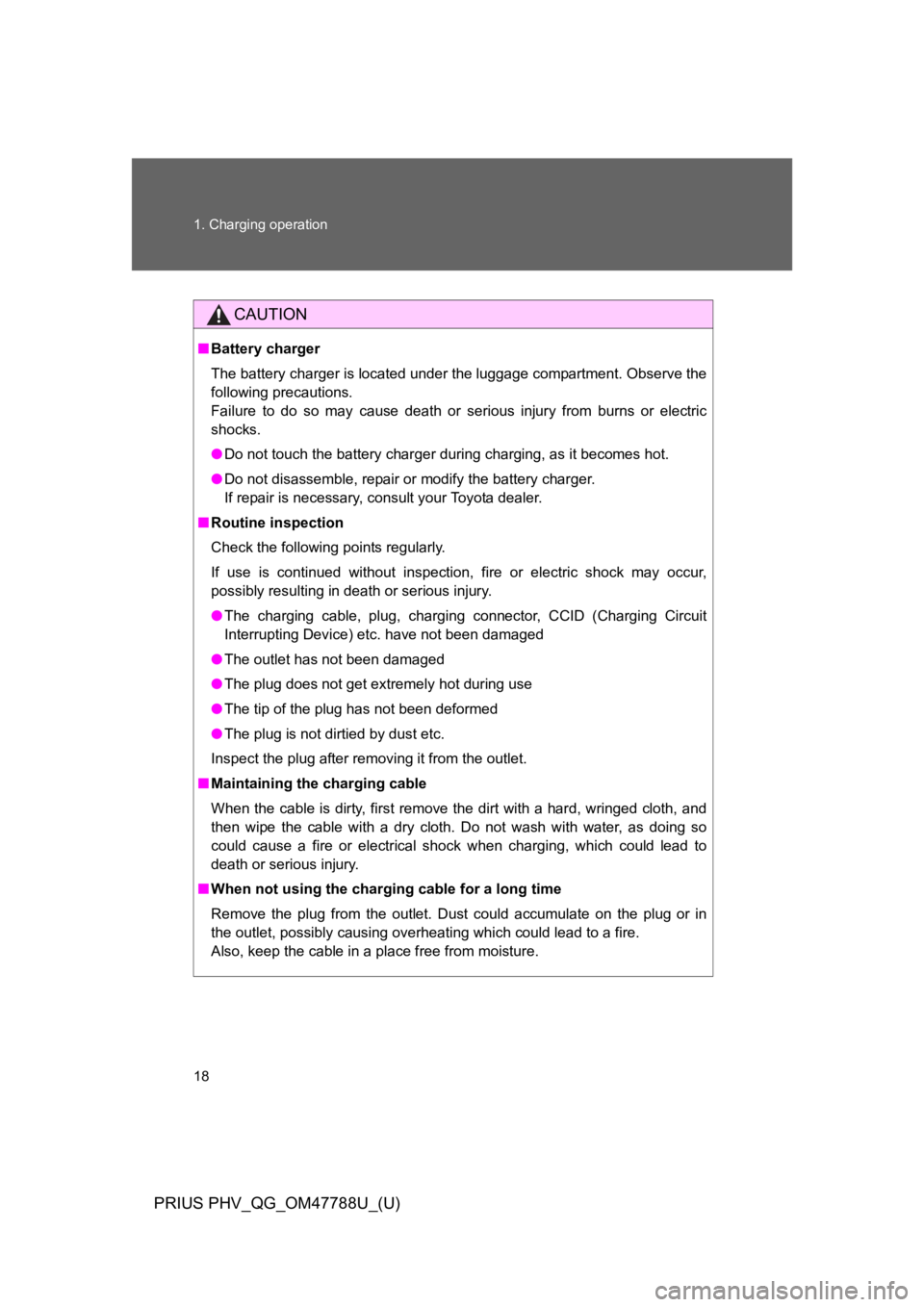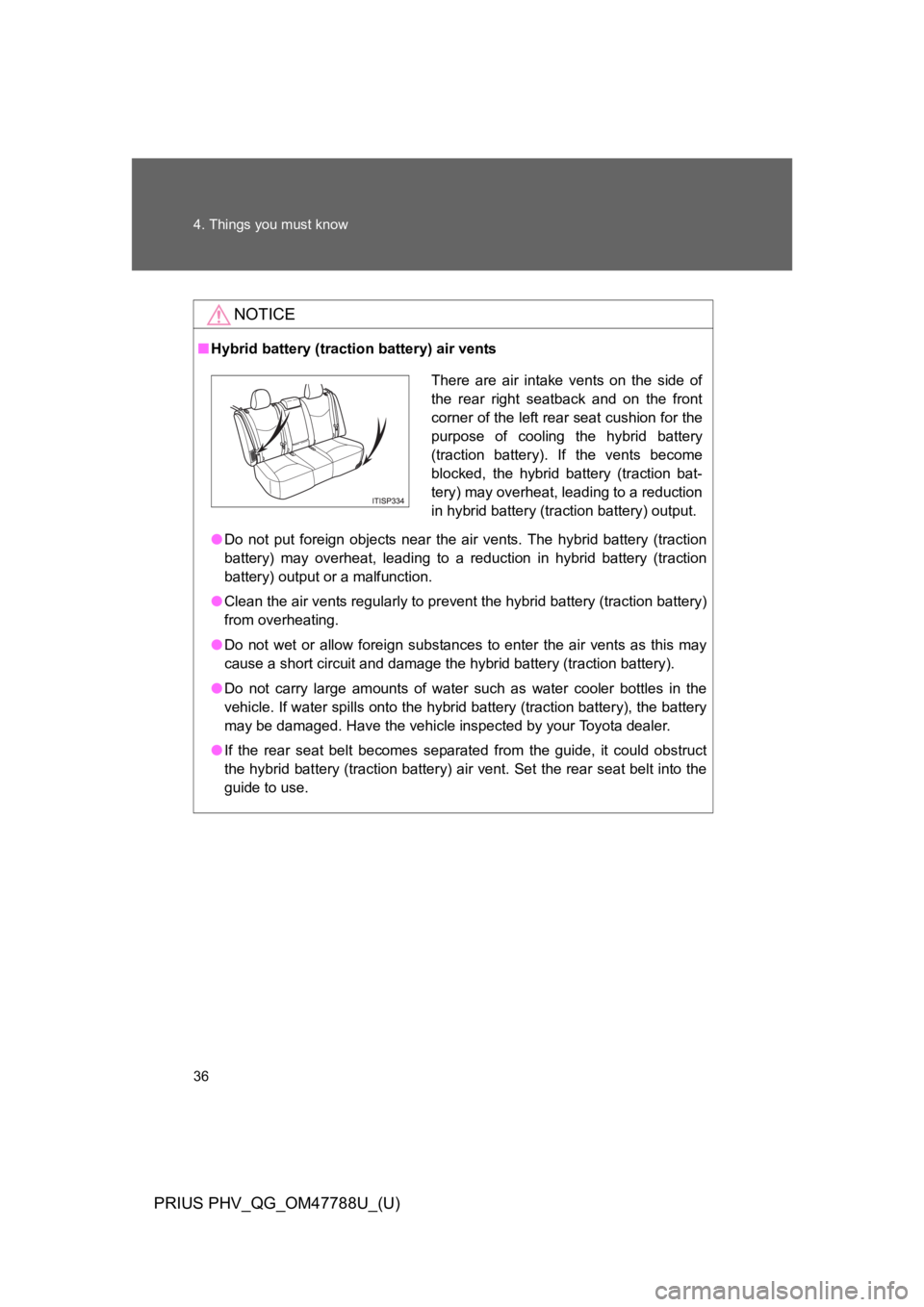2013 TOYOTA PRIUS PLUG-IN battery
[x] Cancel search: batteryPage 9 of 704

9
1. Charging operation
PRIUS PHV_QG_OM47788U_(U)
■Charging timer function
By using the charging timer function, deterioration of the hybrid bat-
tery (traction battery) charge can be suppressed, and off-peak elec-
tricity can be used effectively.
●A charging time can be assigned by setting the charging start time
or finish time.
●Once the time has been set, the time can be assigned again next
time simply by pressing the charging timer switch.
■Setting the charging timer function
Stop the vehicle and press the
charging timer switch.
The multi-information display will
switch to the charging timer dis-
play.
If not changing the set time: go to
Press and hold the charging
timer switch.
The time display will change from
solid to flashing.
STEP1
STEP6
STEP2
Page 18 of 704

18
1. Charging operation
PRIUS PHV_QG_OM47788U_(U)
CAUTION
■Battery charger
The battery charger is located under the luggage compartment. Observe the
following precautions.
Failure to do so may cause death or serious injury from burns or electric
shocks.
●Do not touch the battery charger during charging, as it becomes hot.
●Do not disassemble, repair or modify the battery charger.
If repair is necessary, consult your Toyota dealer.
■Routine inspection
Check the following points regularly.
If use is continued without inspection, fire or electric shock may occur,
possibly resulting in death or serious injury.
●The charging cable, plug, charging connector, CCID (Charging Circuit
Interrupting Device) etc. have not been damaged
●The outlet has not been damaged
●The plug does not get extremely hot during use
●The tip of the plug has not been deformed
●The plug is not dirtied by dust etc.
Inspect the plug after removing it from the outlet.
■Maintaining the charging cable
When the cable is dirty, first remove the dirt with a hard, wringed cloth, and
then wipe the cable with a dry cloth. Do not wash with water, as doing so
could cause a fire or electrical shock when charging, which could lead to
death or serious injury.
■When not using the charging cable for a long time
Remove the plug from the outlet. Dust could accumulate on the plug or in
the outlet, possibly causing overheating which could lead to a fire.
Also, keep the cable in a place free from moisture.
Page 28 of 704

28
3. Basic operation
PRIUS PHV_QG_OM47788U_(U)
■About engine braking
When shift position B is selected, releasing the accelerator pedal will apply
engine braking.
●When the vehicle is driven at high speeds, compared to ordinary gaso-
line-fueled vehicles, the engine braking deceleration is felt less than that
of other vehicles.
●The vehicle can be accelerated even when shift position B is selected.
If the vehicle is driven continuously in the B position, fuel efficiency will
become low. Usually, shift the shift position to D.
NOTICE
■Hybrid battery (traction battery) charge
If the shift position is in N, the hybrid battery (traction battery) will not be
charged. To help prevent the battery from discharging, avoid leaving the N
position selected for an extended period of time.
Page 34 of 704

34
PRIUS PHV_QG_OM47788U_(U)
4. Things you must know
■Regenerative braking
In the following situations, kinetic energy is converted to electric energy and
deceleration force can be obtained in conjunction with the recharging of the
hybrid battery (traction battery).
●The accelerator pedal is released while driving with the shift position in D
or B.
●The brake pedal is depressed while driving with the shift position in D or
B.
■Gasoline engine operation in EV mode
Even if there is a sufficient amount of electricity remaining in the hybrid bat-
tery (traction battery) and EV driving range is being displayed, the gasoline
engine may operate automatically in the following circumstances (EV driving
will be returned to automatically after EV driving becomes possible again):
●When the heater etc. is in use.
●When the temperature of the hybrid system is high.
The vehicle has been left in the sun, driven on a hill, driven at high
speeds, etc.
●When the temperature of the hybrid system is low.
The vehicle has been left in temperatures lower than about 32 °F (0 °C)
for a long period of time etc.
●When power is needed temporarily, for example when accelerating sud-
denly.
●When vehicle speed is more than approximately 62 mph (100 km/h).
●When the accelerator pedal is depressed firmly or the vehicle is on a hill
etc.
●When the outside temperature is low (less than 14 °F [-10 °C])
The gasoline engine may also operate in circumstances other than those
listed above, depending on conditions.
Page 35 of 704

35
4. Things you must know
PRIUS PHV_QG_OM47788U_(U)
■When continually using EV mode only
After driving for approximately 124 miles (200 km) with the gasoline engine
off, the gasoline engine may start for a short amount of time in order to pro-
tect the system.
■Conditions in which the gasoline engine may not stop
The gasoline engine starts and stops automatically. However, it may not stop
automatically in the following conditions*:
●During gasoline engine warm-up
●When the temperature of the hybrid battery (traction battery) is high or
low
●During hybrid battery (traction battery) charging
●When the heater is switched on
*:Depending on the circumstances, the gasoline engine may also not stop
automatically in situations other than those above.
CAUTION
■While driving
Because there is no engine noise when the vehicle is being driven using the
electric motor, pedestrians in the vicinity may not notice the vehicle. Even
though the vehicle is equipped with the vehicle proximity notification system,
drive with care as pedestrians in the vicinity may still not notice the vehicle if
the surrounding area is noisy.
Page 36 of 704

36
4. Things you must know
PRIUS PHV_QG_OM47788U_(U)
NOTICE
■Hybrid battery (traction battery) air vents
●Do not put foreign objects near the air vents. The hybrid battery (traction
battery) may overheat, leading to a reduction in hybrid battery (traction
battery) output or a malfunction.
●Clean the air vents regularly to prevent the hybrid battery (traction battery)
from overheating.
●Do not wet or allow foreign substances to enter the air vents as this may
cause a short circuit and damage the hybrid battery (traction battery).
●Do not carry large amounts of water such as water cooler bottles in the
vehicle. If water spills onto the hybrid battery (traction battery), the battery
may be damaged. Have the vehicle inspected by your Toyota dealer.
●If the rear seat belt becomes separated from the guide, it could obstruct
the hybrid battery (traction battery) air vent. Set the rear seat belt into the
guide to use.
There are air intake vents on the side of
the rear right seatback and on the front
corner of the left rear seat cushion for the
purpose of cooling the hybrid battery
(traction battery). If the vents become
blocked, the hybrid battery (traction bat-
tery) may overheat, leading to a reduction
in hybrid battery (traction battery) output.
Page 53 of 704

24
PRIUS PHV_OM_OM47787U_(U)
Ve h i c l e d a ta r e c o r d i n g s
Yo u r To y o t a i s e q u i p p e d w i t h s e v e r a l s o p h i s t i c a t e d c o m p u t e r s t h a t w i l l r e c o r d
certain data, such as:
•Engine speed
•Electric motor speed (traction motor speed)
• Accelerator status
•Brake status
•Vehicle speed
•Shift position
•Hybrid battery (traction battery) status
The recorded data varies according to the vehicle grade level and options
with which it is equipped. Furthermore, these computers do not record con-
versations, sounds or pictures.
●Data usage
To y o t a m a y u s e t h e d a t a r e c o r d e d i n t h e s e c o m p u t e r s t o d i a g n o s e m a l f u n c -
tions, conduct research and development, and improve quality.
To y o t a w i l l n o t d i s c l o s e t h e r e c o r d e d d a t a t o a t h i r d p a r t y e x c e p t :
• With the consent of the vehicle owner or with the consent of the lessee if
the vehicle is leased
•In response to an official request by the police, a court of law or a govern-
ment agency
•For use by Toyota in a lawsuit
•For research purposes where the data is not tied to a specific vehicle or
vehicle owner
●Usage of data collected through Safety Connect (U.S. mainland only)
If your Toyota has Safety Connect and if you have subscribed to those ser-
vices, please refer to the Safety Connect Telematics Subscription Service
Agreement for information on data collected and its usage.
Page 57 of 704

28
PRIUS PHV_OM_OM47787U_(U)
CAUTION
■Hybrid battery (traction battery)
Never resell, hand over or modify the hybrid battery (traction battery). To pre-
vent accidents, hybrid batteries (traction batteries) that have been removed
from a disposed vehicle are collected through Toyota dealers. Do not dis-
pose of the battery yourself.
Unless the battery is properly collected, the following may occur, resulting in
death or serious injury:
•The hybrid battery (traction battery) may be illegally disposed of or
dumped, and someone may touch a high voltage part, resulting in an
electric shock.
•The hybrid battery (traction battery) is intended to be used exclusively
with your hybrid vehicle. If the hybrid battery (traction battery) is used
outside of your vehicle or modified in any way, accidents such as electric
shock, heat generation, smoke generation, an explosion and electrolyte
leakage may occur.
When reselling or handing over your vehicle, the possibility of an accident is
extremely high because the person receiving the vehicle may not be aware
of these dangers.
■Disposal of the hybrid battery (traction battery)
If your vehicle is disposed of without the hybrid battery (traction battery) hav-
ing been removed, there is a danger of serious electric shock if high voltage
parts, cables and their connectors are touched. In the event that your vehicle
must be disposed of, the hybrid battery (traction battery) must be disposed
of by your Toyota dealer or a qualified service shop. If the hybrid battery
(traction battery) is not disposed of properly, it may cause electric shock that
can result in death or serious injury.